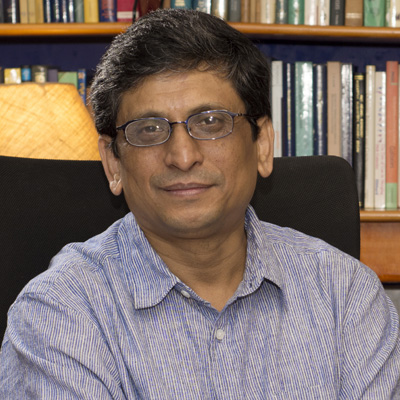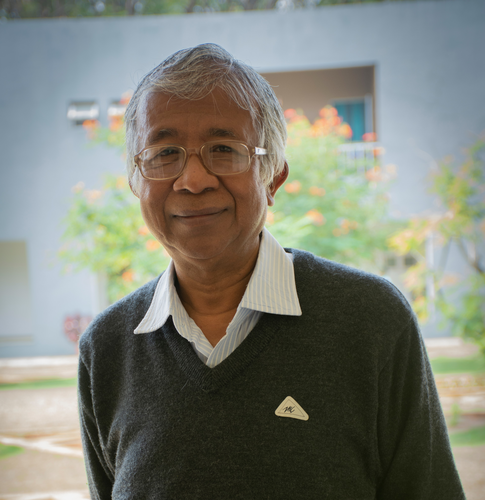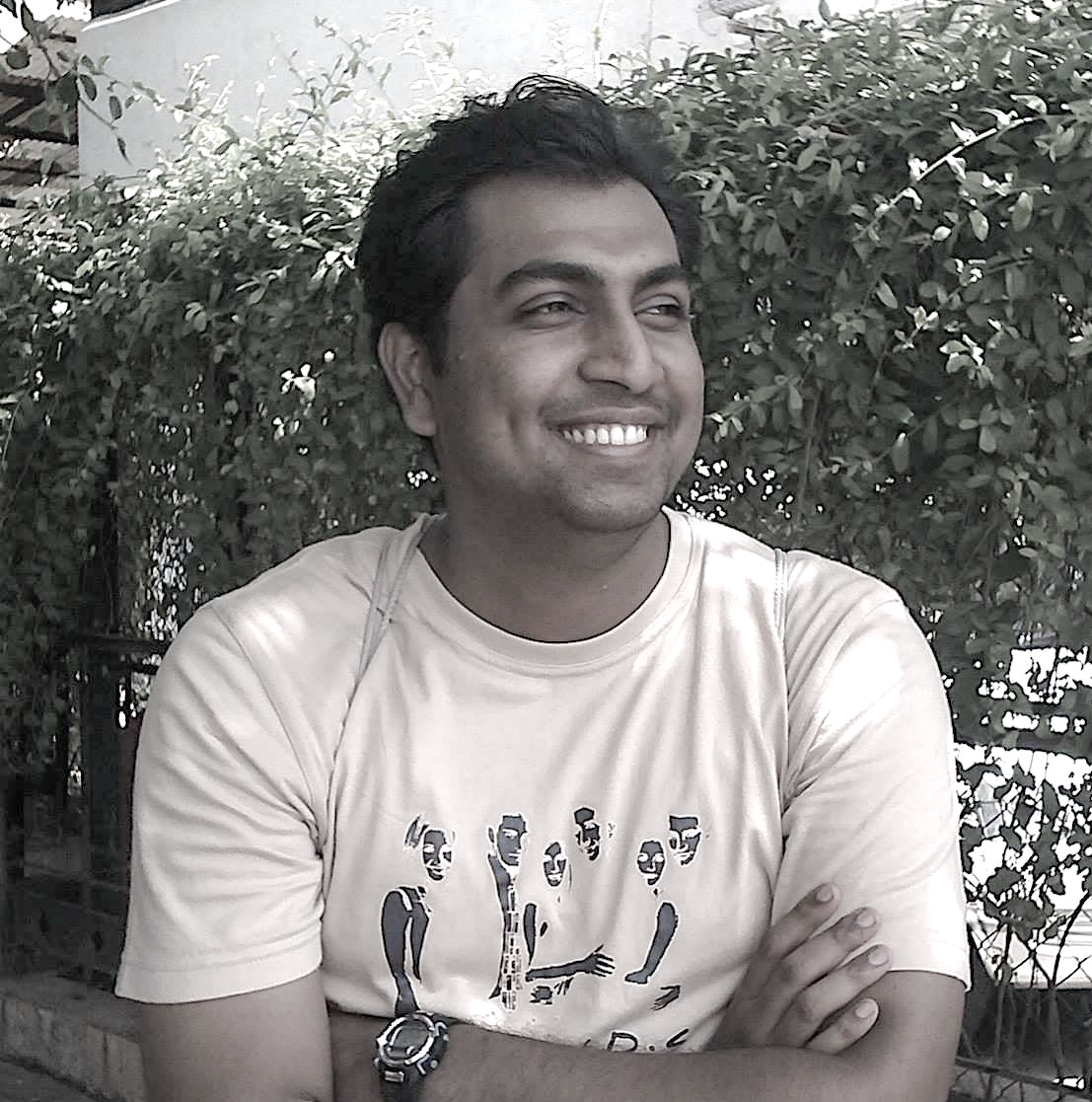 |
||
|
IUCAA scientists discover an enigmatic giant radio galaxy! Scientists detect jets from a supermassive black hole blowing out gas from a galaxy |
||

Figure 1: Radio emission shown in blue and red (high resolution) colour based on observations from GMRT with the optical background image from SDSS.
DOI: https://doi.org/10.1051/0004-6361/202243182
Giant radio galaxies are the largest single astrophysical objects in the Universe with sizes of over a few million light years. These gigantic objects are often larger than about 30 Milky Way-sized galaxies placed in a single line. Their huge sizes are due to collimated jets of highly energetic particles squirting out from supermassive black holes of about a billion solar masses or more residing in the centres of these radio-loud active galaxies. IUCAA scientists have been studying this class of objects which pose a number of challenging astrophysical questions over many years. They have reported the discovery of hundreds of giant radio sources from deep surveys at radio wavelengths accounting for a major fraction of all such sources known.
In their recent work, an international team including IUCAA scientists have reported an enigmatic barbell-shaped giant radio galaxy J223301+131502 from observations with the Giant Metrewave Radio Telescope (GMRT) in India and the Low-Frequency Array (LOFAR) in Europe at radio wavelengths and with the William Herschel Telescope in the Canary Islands, Spain, at optical wavelengths. This giant radio galaxy is about 6 million light-years across and exhibits a number of interesting features including a prominent kink and twist in the jets and diffuse relic lobes. The observed features in the jets are possibly due to a combination of the development of plasma instabilities and the precession of the central supermassive black hole. Dr. Pratik Dabhade, formerly at IUCAA and now at the Instituto de Astrofísica de Canarias, who led this project said that ‘we initially noticed the peculiar morphology in a unique environment. However, only after sensitive observations with GMRT and LOFAR, its exceptionally long, collimated, and powerful jets were unveiled’.
‘The diffuse relic lobes with the radio jets reaching its inner edges suggest that the jet activity from the supermassive black hole could be episodic, which has many interesting astrophysical implications’ opined Professor Dhruba J Saikia from IUCAA. This giant radio galaxy is about 200 million years old and resides in a cluster of galaxies. Professor Somak Raychaudhury, Director, IUCAA highlighted that ‘this source provides an opportunity of studying the interaction of the jets with the external cluster environment from deep observations at x-ray wavelengths’. The team has been granted time to observe the source with the highly competitive Chandra X-ray Observatory. Professor Huub Rottgering from Leiden Observatory, the Netherlands, summarised to say that ‘these fascinating observations show that the long life of this radio galaxy was full of events: big obstacles had to be overcome for the source to be able to grow to a size about sixty times larger than our Galaxy’.
In their recent work, an international team including IUCAA scientists have reported an enigmatic barbell-shaped giant radio galaxy J223301+131502 from observations with the Giant Metrewave Radio Telescope (GMRT) in India and the Low-Frequency Array (LOFAR) in Europe at radio wavelengths and with the William Herschel Telescope in the Canary Islands, Spain, at optical wavelengths. This giant radio galaxy is about 6 million light-years across and exhibits a number of interesting features including a prominent kink and twist in the jets and diffuse relic lobes. The observed features in the jets are possibly due to a combination of the development of plasma instabilities and the precession of the central supermassive black hole. Dr. Pratik Dabhade, formerly at IUCAA and now at the Instituto de Astrofísica de Canarias, who led this project said that ‘we initially noticed the peculiar morphology in a unique environment. However, only after sensitive observations with GMRT and LOFAR, its exceptionally long, collimated, and powerful jets were unveiled’.
‘The diffuse relic lobes with the radio jets reaching its inner edges suggest that the jet activity from the supermassive black hole could be episodic, which has many interesting astrophysical implications’ opined Professor Dhruba J Saikia from IUCAA. This giant radio galaxy is about 200 million years old and resides in a cluster of galaxies. Professor Somak Raychaudhury, Director, IUCAA highlighted that ‘this source provides an opportunity of studying the interaction of the jets with the external cluster environment from deep observations at x-ray wavelengths’. The team has been granted time to observe the source with the highly competitive Chandra X-ray Observatory. Professor Huub Rottgering from Leiden Observatory, the Netherlands, summarised to say that ‘these fascinating observations show that the long life of this radio galaxy was full of events: big obstacles had to be overcome for the source to be able to grow to a size about sixty times larger than our Galaxy’.
Links to the paper and related material:
- Link to the article published: https://phys.org/news/2022-10-peculiar-giant-radio-galaxy-grg-j223301131502.html
- Link to the paper: https://www.aanda.org/component/article?access=doi&doi=10.1051/0004-6361/202243182
Contacts:
 |
Prof. Somak Raychaudhury (IUCAA, India) E-mail: somak_at_iucaa.in Phone: +91-20-25604231 |
 |
Prof. Dhruba J Saikia (IUCAA, India) E-mail: dhrubasaikia_at_iucaa.in |
 |
Dr. Pratik Dabhade (LERMA, France) E-mail: pratikdabhade13_at_gmail.com |
Team members:
- Dabhade, Pratik: LERMA, Observatoire de Paris, Paris, France.
- Shimwell, Timothy W.: ASTRON, The Netherlands and Leiden Observatory, The Netherlands
- Bagchi, Joydeep: Department of Physics and Electronics, CHRIST (Deemed to be University), Bengaluru-560029, India and Inter-University Centre for Astronomy and Astrophysics (IUCAA), India
- Saikia, D. J.: Inter-University Centre for Astronomy and Astrophysics (IUCAA), India and Department of Physics, Tezpur University, Tezpur 784028, India
- Combes, Françoise: Observatoire de Paris, Paris, France
- Gaikwad, Madhuri: Max-Planck-Institute for Radio Astronomy, Bonn, Germany
- Rottgering, Huub: Leiden Observatory, The Netherlands
- Mohapatra, Abhisek: Inter-University Centre for Astronomy and Astrophysics (IUCAA), Pune 411007, India
- Ishwara-Chandra, C. H: National Centre for Radio Astrophysics, TIFR, India
- Intema, Huib T.: Leiden Observatory, The Netherlands
- Raychaudhury, Somak: Inter-University Centre for Astronomy and Astrophysics (IUCAA), India and School of Physics and Astronomy, University of Birmingham, Birmingham, UK


